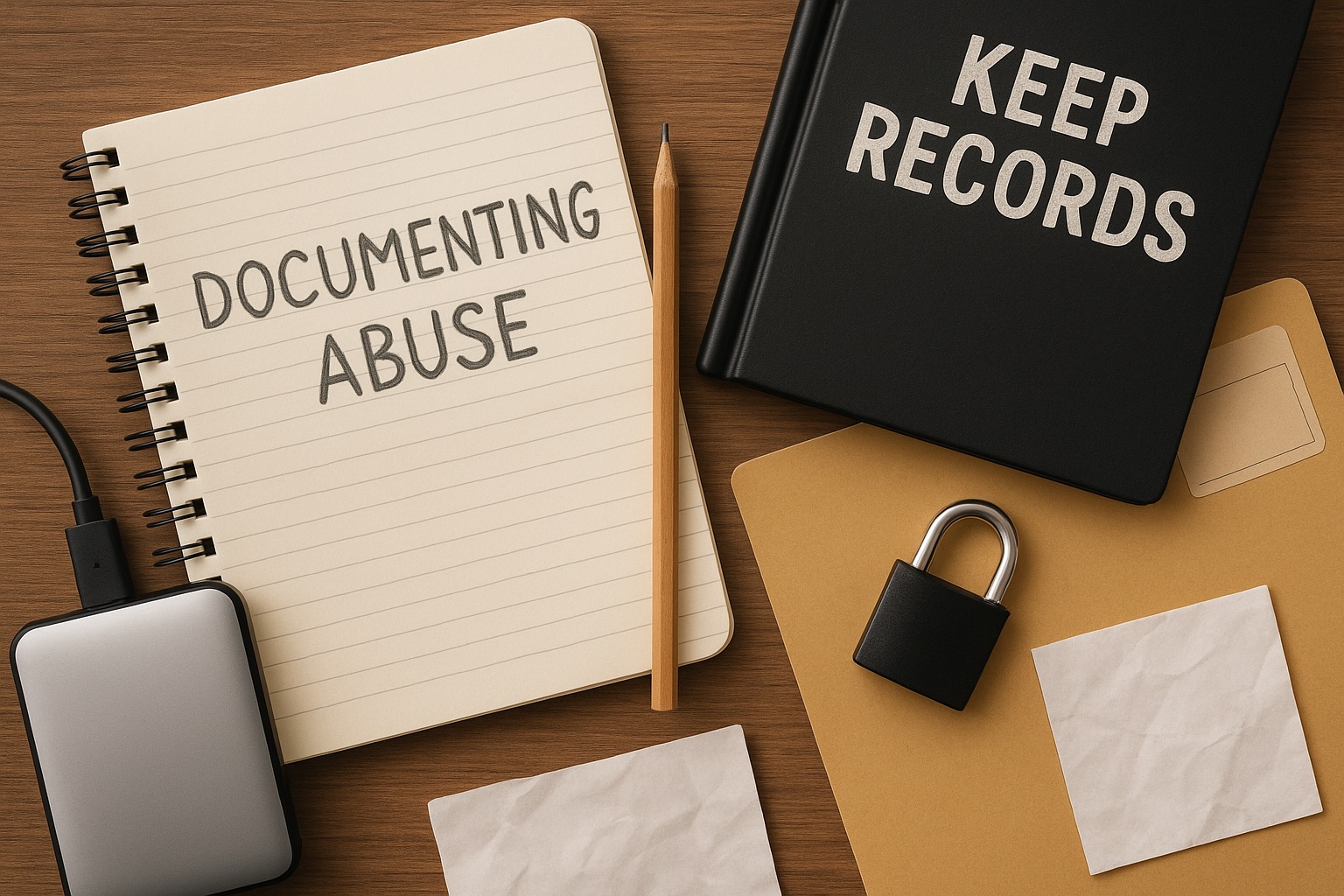Documenting Abuse: How to Keep Records Safely for Potential Legal Action
You don’t need to press charges to start documenting abuse. Keeping safe, detailed records can protect you—and help if you later seek a restraining order, custody, or criminal charges.

Whether you’re thinking about a restraining order, planning to leave, or just want to protect yourself, it’s smart to start documenting abuse as early as you safely can.
You don’t need to confront your abuser or press charges to begin—just keeping records can help with:
Custody hearings
Peace or restraining orders
Police reports
Family or immigration court
⚠️ Step 1: Prioritize Your Safety First
Never document abuse if it puts you at immediate risk
Use safe storage options (burner email, password-protected file, hidden notebook)
Don’t leave physical notes where your abuser can find them
Consider using a secure app (like "myPlan" or "DocuSAFE" by NNEDV)
🗂️ Step 2: What to Document
✅ Physical Abuse
Date/time, location, what happened
Description of injuries
Photos (with date stamp if possible)
Hospital or doctor visit summaries
✅ Emotional or Verbal Abuse
Direct quotes or threats
Notes on manipulation or humiliation
Impact on mental health (e.g., anxiety, fear, isolation)
✅ Financial Control
Screenshots or photos of bank denials, withheld funds, or blocked access
Pay stubs or proof of stolen income
Bills left unpaid to control you
✅ Digital Abuse or Stalking
Screenshots of texts, emails, or DMs
Records of unauthorized access to your accounts
Log unusual surveillance, tracking, or device tampering
✅ Witnesses or Third-Party Reports
Names of anyone who saw or heard abuse
Notes if you disclosed to a friend, therapist, or worker
📸 Step 3: How to Safely Store Evidence
Email it to a trusted person or a hidden cloud account
Use encrypted storage apps or password-protected folders
Keep a burner notebook hidden in a coat, vehicle, or workplace locker
Print photos and keep them outside the home (e.g., at a friend’s)
Pro Tip: Use vague labels like “Receipts” or “Insurance” to disguise folders or files.
🧑⚖️ Step 4: When and How to Use Your Records
If reporting to police: Bring your notes and evidence
If filing for a restraining order (e.g., Form 9C in Ontario): Use examples from your records
If seeking custody: Show patterns of control, abuse, or risk to the children
If speaking with Legal Aid or a lawyer: Your documentation gives them a head start
🧠 Step 5: Take Care of Your Mental Health
Revisiting abusive incidents can be emotionally painful
Try journaling in a way that helps you feel empowered, not overwhelmed
Reach out to trauma-informed counsellors or DV advocates
You’re doing something brave—don’t do it alone
📌 Summary: Tips for Documenting Abuse
✅ Only record if it’s safe
✅ Include date, time, and specific details
✅ Use safe storage (cloud, encrypted apps, trusted friends)
✅ Keep copies outside the home
✅ You don’t have to wait to use them—your story matters now
📞 Where to Get Help in Ontario
Assaulted Women’s Helpline: 1-866-863-0511
Barbra Schlifer Clinic: Legal and safety support for women
Luke’s Place: Legal help with custody and documentation
211 Ontario: Find trauma counselling and local DV support
DocuSAFE app: Free tool to document abuse safely (available on iOS/Android)
Frequently Asked Questions (FAQs)
1. Why is it so important to document abuse?
Documenting abuse creates a detailed timeline of evidence. This can be crucial in court to show a judge a pattern of behaviour, which is much more powerful than relying on memory alone. These records can be the key to getting a restraining order, proving your case in a custody dispute, or supporting criminal charges.
2. What if my abuser finds my records?
This is a serious safety risk. Your priority must be to store your records in a place the abuser cannot access. If you fear your records might be found, it may be safer to confide in a trusted friend who can keep notes for you, or to wait until you are in a safe place to begin documenting.
3. I don't have any physical injuries to photograph. Should I still document?
Yes, absolutely. Documenting emotional abuse, threats, financial control, and stalking is just as important. Your detailed log of these non-physical incidents helps to establish a pattern of coercive control, which is a form of abuse recognized by the family courts in Ontario.
4. How can my records be used in court?
Your records are your evidence. You can use them to:
- Provide a detailed statement to the police.
- Fill out the affidavit for a restraining order application.
- Show your lawyer to give them a clear history of the abuse.
- Help you accurately recall events if you have to testify in court.
5. What is the most important thing to include in my documentation?
The most important things are dates, details, and direct quotes. Be as specific and factual as possible. For example, instead of writing "He was angry," write "On August 1, 2025, at 8:00 PM, he slammed his fist on the table and shouted, 'You're worthless!'"
6. Where can I get help with documenting abuse safely in Ontario?
You can get confidential support and advice on safe documentation from the Assaulted Women's Helpline (1-866-863-0511). They can help you create a safety plan that includes how to keep records without putting yourself at further risk. Apps like DocuSAFE are also designed for this specific purpose.
